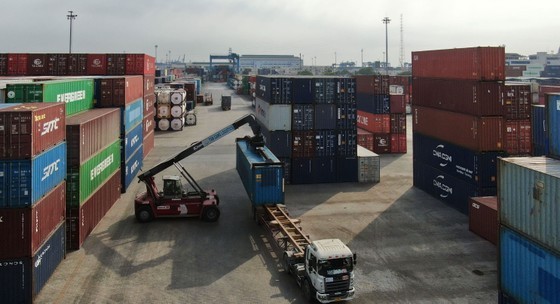In 2023, the Ministry of Transport set a target of 7 percent growth in freight volume and 8 percent passenger volume. Along with that, the Ministry will continue to restructure the transport market share in the direction of reducing road transport and increasing inland waterway and railway transport. However, the Ministry bumped into difficulties in restructuring the transport market share when investment in roads still prevails.
 |
People still choose transportation by road
According to the Ministry of Transport, the transport capacity of the transport system, especially on the North-South axis, is disproportionately large. Currently, road transport still accounts for 70 percent of total passenger volume and 73. percent of total cargo volume while water transport accounted for 5 percent of total passenger volume and nearly 21.2 percent of total cargo volume; railway transport accounts for only about 5 percent of total passenger volume and 1.6 percent of total cargo volume. The rest is by sea and by air.
This huge disproportion has led to the very high cost of logistics services in Vietnam, currently equivalent to 20 percent of GDP, much higher than other countries in the region and twice the global average of 10.8 percent. In particular, in the structure of logistics costs in Vietnam, transportation costs account for 30 percent to 40 percent of product costs, especially agricultural products.
According to the actual survey, the cost of transporting a 40-foot container by road from Ho Chi Minh City to Hanoi is about VND40 million, 9.7 times higher than sea transport and 2.5 times higher than rail transport, mainly due to high fuel prices, traffic jams and many kinds of expenses. However, customers still prefer road transport.
Mr. Tran Quang Thanh from Hanoi-based Hoa Viet Transport Company said that road transport is preferred because this method can connect directly with seaports, airports, and railway stations and can be about shipping time. In particular, agricultural products are almost completely dependent on roads because they can be flexible in terms of transport volume and time; plus, procedures are much simpler than shipping by rail, air, or water.
Mr. Nguyen Van Quyen, Chairman of the Vietnam Automobile Transport Association, commented that road transport is dominant because the road system across the country has been greatly invested and developed over the past 10 years; thus, road transport is better to meet travel and freight needs. However, the excessive dependence on transport on roads has put great pressure on traffic infrastructure, affecting traffic safety and the quality of road traffic works.
Investment imbalance
According to economic experts, the current transport structure is a consequence of the imbalance in investment in transport infrastructure for many years.
According to a survey to collect data for the Sustainable Transport Development Strategy in Vietnam by JICA (Japan), the government has allocated VND980,000 billion (US$ 41,831,199,774) for the country’s transport sector in the period 2011-2020 for the construction of infrastructure.
Of the amount of VND980,000 billion which is equivalent to 2.2 percent of the total annual GDP in the same period, VND 573,000 billion has been poured into road construction; VND 202,000 billion into sea transportation; VND90,000 billion into aviation transportation and VND73 trillion into waterway transportation. Finally, the railway once considered the backbone of the country’s economy received only VND39,000 billion, equal to 7 percent of the road.
From 2021 to 2025, the total length of highways completed is nearly four times higher than the period between 2015 to 2020, which means that the total investment capital from the expressway implementation budget this period is nearly 4 times higher than the period from 2015 to 2020, up to VND339 trillion.
Currently, expressways have been built in 29 provinces and cities in all three regions of the North, Central and South. The remaining provinces have also proposed to expand the expressway network. The Government aimed to complete 5,000km of highways from now to 2030 or all localities have highways to increase regional connectivity and economic development.
A representative of the Department of Planning and Investment under the Ministry of Transport said that although the national railway passes through 34 provinces and cities, there has been almost no proposal to invest in railway infrastructure from other provinces including the project of paths connecting to industrial parks in the area in the past 10 years.
Currently, many preferential policies for railway development, such as exemption and reduction of land use tax for railway industrial establishments, as stipulated in the Law on Railways have not yet been implemented.
Every year, in their document, the Vietnam Railways Corporation and the Ministry of Transport requested localities to temporarily suspend the implementation of land use tax.
Similar to railways, the inland waterway sector has many advantages in terms of natural conditions and transportation costs but has not received adequate investment for many years; subsequently, it can’t share the burden of road transportation.
According to experts, it is time for the transport industry to drastically restructure transport to achieve the goal of reducing logistics costs including speeding up projects in the transportation sector which will be the most effective solution to reduce road transport, increase the market share of inland waterway transport and railway.
Information from the Ministry of Transport said that impressive growth in transport volume was one of the highlights in the first quarter of 2023. According to statistics, cargo transport in March-2023 is estimated at 185 million tons, up 24 percent over the same period in 2022 and three months' accumulation is estimated at 550 million tons, an increase of more than 16 percent over the same period in 2022.
Passenger transport in March-2023 was estimated at more than 372 million passengers, an increase of more than 17 percent over the same period in 2022. The accumulative number of visitors in three months is estimated at 1,115 million, an increase of nearly 29 percent over the same period in 2022.
























